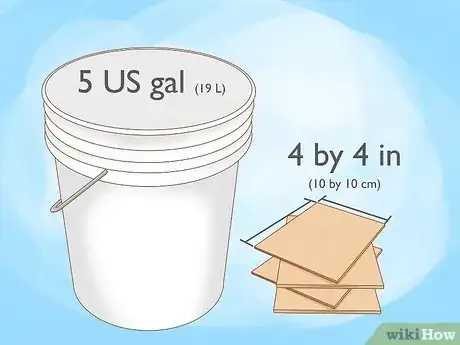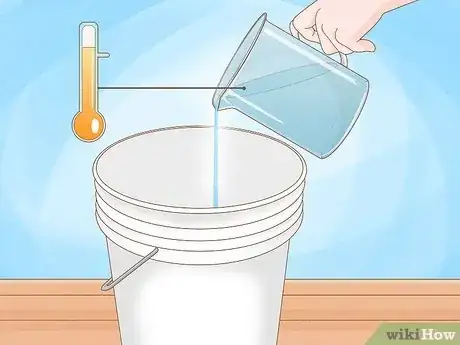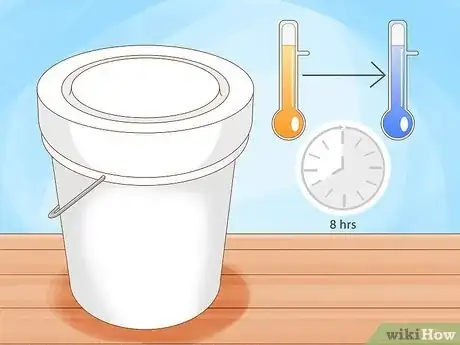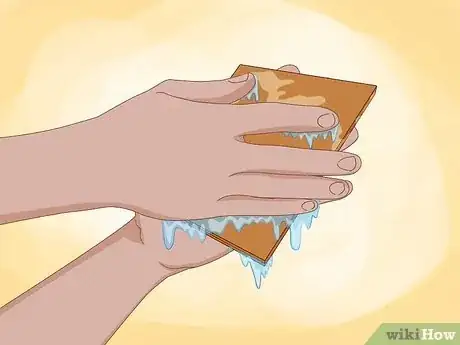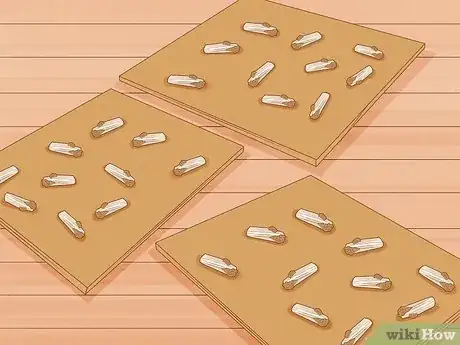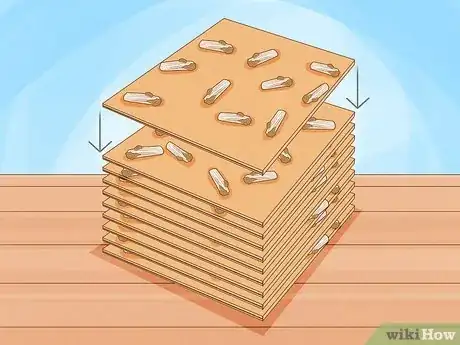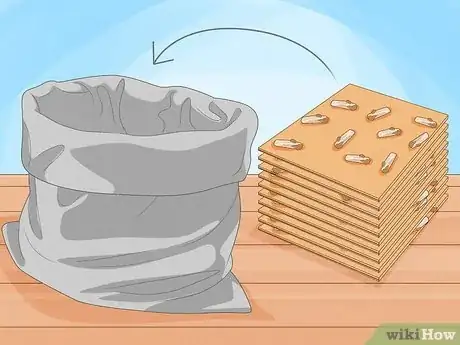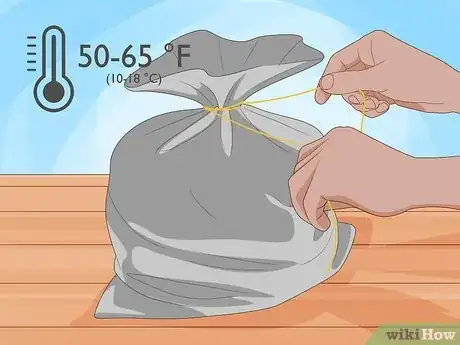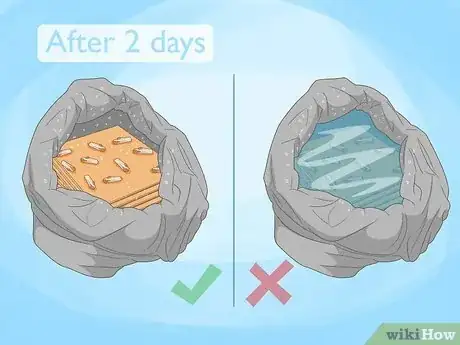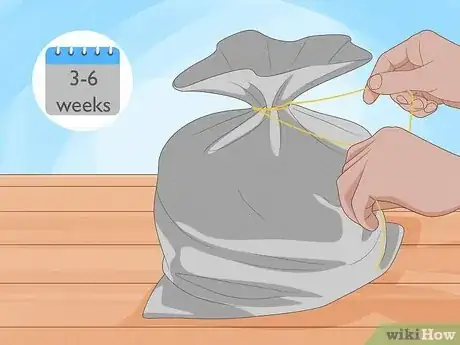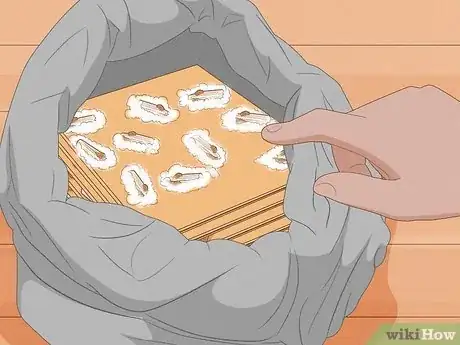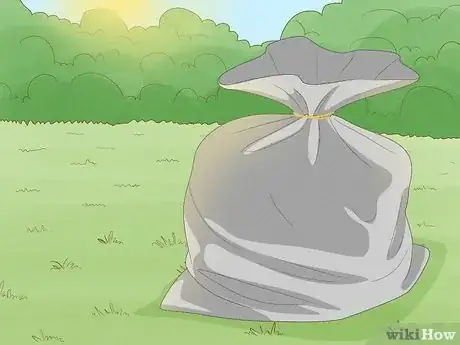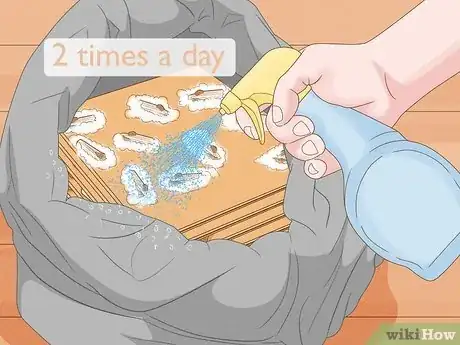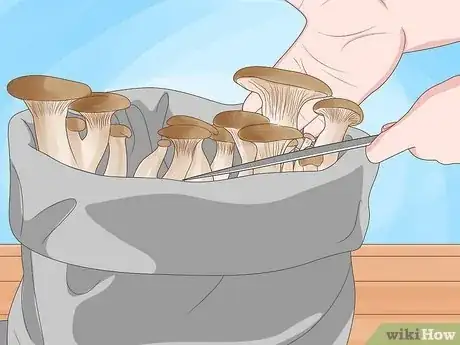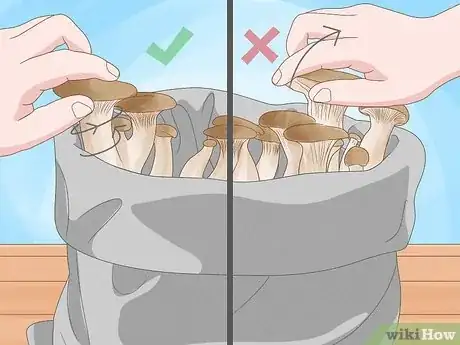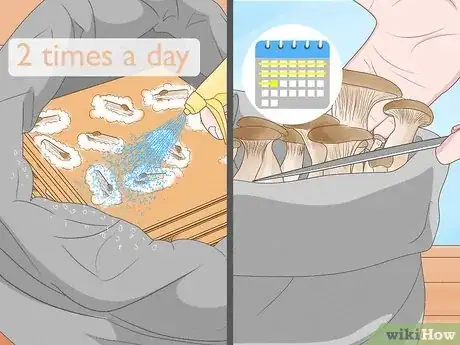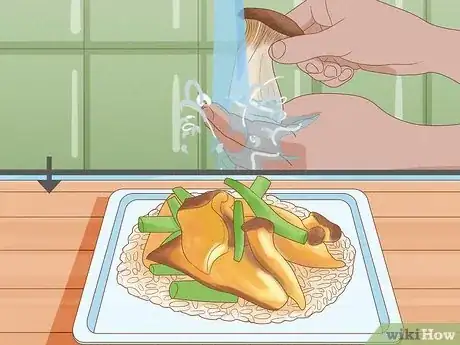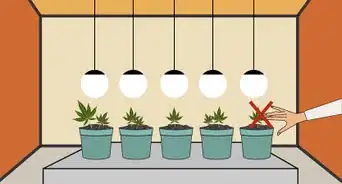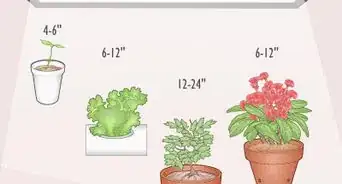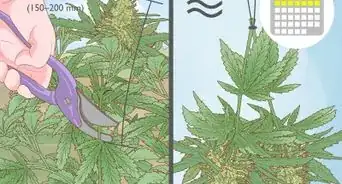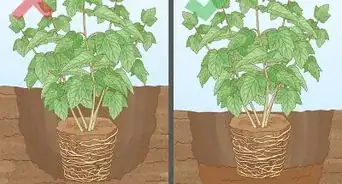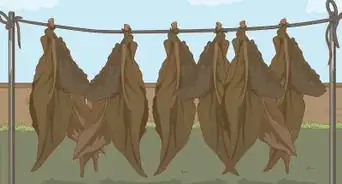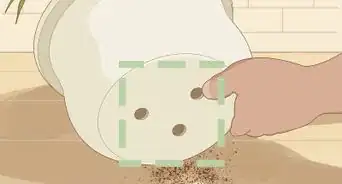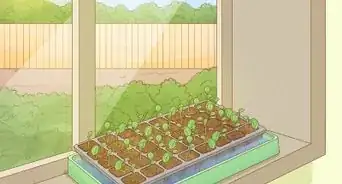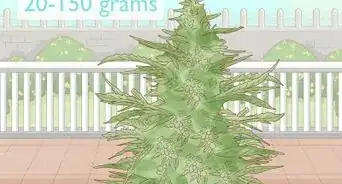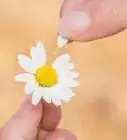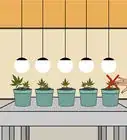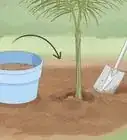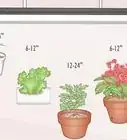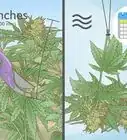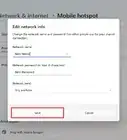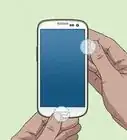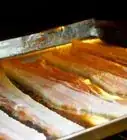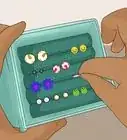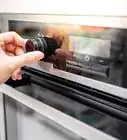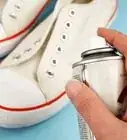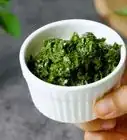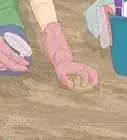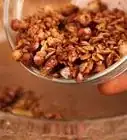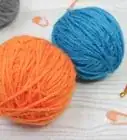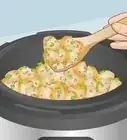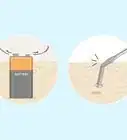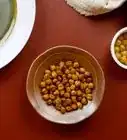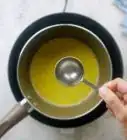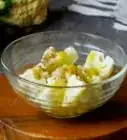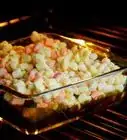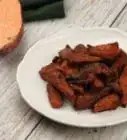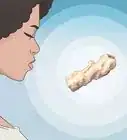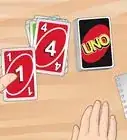This article was co-authored by Lauren Kurtz and by wikiHow staff writer, Hunter Rising. Lauren Kurtz is a Naturalist and Horticultural Specialist. Lauren has worked for Aurora, Colorado managing the Water-Wise Garden at Aurora Municipal Center for the Water Conservation Department. She earned a BA in Environmental and Sustainability Studies from Western Michigan University in 2014.
There are 8 references cited in this article, which can be found at the bottom of the page.
This article has been viewed 46,494 times.
King oyster mushrooms are the largest of the oyster mushroom species and have been described as having the taste and texture of abalone.[1] One of the best parts about oyster mushrooms is that they’re easy for you to grow at home! With a little time and effort, you can grow your own mushrooms to include in a variety of dishes!
Steps
Creating a Grow Area
-
1Cut cardboard into 4 by 4 in (10 by 10 cm) squares and put them in a bucket. Use a box cutter or utility knife to cut the cardboard down to size. Aim to have about 10 pieces of cardboard in the end, but it’s okay if you have more or less. Place the cardboard pieces in a sanitized 5 US gal (19 L) bucket.[2]
- Cardboard egg cartons would also work well for growing the mushrooms.
- You can sanitize your bucket with a diluted bleach solution.
-
2Boil water and pour it over the cardboard until it is completely saturated. Place a large pot or kettle on the stove until the water boils. Pour the hot water onto the cardboard until it’s completely wet through and submerged. This helps kill any organisms that may contaminate your mushrooms later on.[3]
- Push the cardboard down to compact it if you want to use less water.
- The boiled water will kill any microorganisms on the cardboard in a process called pasteurization.
Advertisement -
3Cover the bucket and let it cool for 8 hours. Put a lid on top of the bucket and let it soak overnight. The heat from the water would kill any mushroom spawn, so it needs to rest until it is cool to the touch.[4]
-
4Squeeze the cardboard to drain any excess water. Pour the water out of the bucket and drain the rest of the water from the cardboard squares. Start squeezing on 1 side of the square and work your way across. In the end, they should be damp to the touch, but not completely saturated.[5]
- Wash your hands with antibacterial soap or use hand sanitizer before handling the cardboard so you don’t bring in foreign contaminants.
-
5Place 10 mushroom spawn on 1 piece of cardboard. Sprinkle the spawn evenly near the edges of the cardboard square. The king oyster mushrooms prefer to grow from the sides of the cardboard rather than on top of the cardboard.[6]
- Check your local gardening store to see if they have spawn for king oyster. Otherwise, king oyster mushroom spawn can be purchased online.
-
6Stack the squares on top of one another, placing spawn on each layer. Continue building layers of the cardboard and spawn until you’re out of cardboard. Don’t place any of the spawn on top of the last piece of cardboard since it will not be covered and may not grow as effectively.[7]
- You’ll need about 100 mushroom spawn total to grow on 10 layers of cardboard, but you don’t have to be precise with your count.
Fruiting the Mushrooms
-
1Place the cardboard squares and spawn into a garbage bag and close it. Use a garbage bag with a cinch for the easiest way to close it. Closing the bag builds up the concentration of carbon dioxide inside and stimulates the mushroom spawn to grow faster.[8]
- Place the garbage bag in a cardboard box if you want to keep it safer.
- The mushrooms do not need light as they establish.
-
2Keep the bag in an area between 50–65 °F (10–18 °C). Keep the bag in a warm dark place, like a cabinet, to help the spawn colonize more quickly. The warmth mixed with the moisture in the cardboard pieces creates a humid environment that’s perfect for mushrooms.[9]
- The bag can be stored in a dark cabinet or even under your bed.
-
3Open the bag after 2 days to check for pools of water. While the bag should stay humid and moist, it should not have pools of standing water at the bottom. If you find excess water, drain the bag into a sink before putting it back.[10]
- This should only have to be done once since the water is excess that has drained from the cardboard.
-
4Leave the bag alone for 3-6 weeks. Don’t disturb the bag during this time since the mushroom spawn is starting to produce mycelium, which looks like white strands, and will eventually fruit. The cardboard will be completely colonized by the mushroom after this time.[11]
- Set a reminder on your phone or in a planner so you know when to return to your mushrooms.
-
5Open the plastic bag once you see white strands covering the cardboard. After the third week, check every 2 weeks to see if the mycelia have formed. It will look like the cardboard is covered in white strands if it’s ready. If it isn’t, close the bag and leave it alone for another week or two before checking it again.[12]
- Opening the bag exposes the mycelia to oxygen and will stimulate it to start producing mushrooms.
-
6Move the bag to a sunny area when the mycelia is present. Make sure there is enough light getting to your mushrooms. A good rule of thumb is to have it bright enough so you could easily read a book. During this time, you may see small mushrooms starting to form.[13]
-
7Spray the inner walls of the bag with water twice daily. Maintain a humid environment for the mushrooms by using a spray bottle with tap water. Wet the walls of the bag to keep the mushrooms moist.[14]
- Mushrooms may not tolerate water sprayed directly on them.
- If you live in a dry climate, spray 3 times per day.
Harvesting the Mushrooms
-
1Collect the mushrooms before they develop a wavy edge. The mushrooms should only take 1 to 2 weeks to fully grow, but they will develop a wavy edge around their cap when they are starting to go past their prime. They can still be eaten, but for best results, pick full-sized mushrooms just as they finish growing.[15]
- Pin mushrooms are part of the first flush of growth and will become full size within 3 to 4 days.
-
2Twist the mushrooms off of their base. Avoid pulling the mushroom straight off since this could damage the mycelia underneath. A gentle twist and pull should be all it takes to remove the mushrooms.[16]
- As an alternative, you can cut the base of the mushrooms with a pair of sanitized scissors.
-
3Spray the bag with water twice a day to get more flushes of mushrooms. After 10 to 15 days, you may see another growth of mushrooms if you keep the bag moist and in a light place. They will tend to be just as large, if not larger, than the first mushrooms you collected.[17]
- Mushrooms can return for multiple flushes every 2 or 3 weeks, but they will grow smaller each time.
-
4
Things You’ll Need
- Cardboard
- Box cutter
- Bucket
- Pot or kettle
- Mushroom spawn
- Garbage bag
- Spray bottle
References
- ↑ https://www.thekitchn.com/ingredient-spotlight-king-trum-110829
- ↑ http://verticalveg.org.uk/how-to-grow-oyster-mushrooms-at-home/
- ↑ http://verticalveg.org.uk/how-to-grow-oyster-mushrooms-at-home/
- ↑ https://youtu.be/Qfk95bI-jhs?t=13s
- ↑ https://youtu.be/Qfk95bI-jhs?t=24s
- ↑ https://youtu.be/Qfk95bI-jhs?t=1m39s
- ↑ https://youtu.be/Qfk95bI-jhs?t=2m1s
- ↑ https://youtu.be/Qfk95bI-jhs?t=2m36s
- ↑ http://verticalveg.org.uk/how-to-grow-oyster-mushrooms-at-home/
- ↑ http://verticalveg.org.uk/how-to-grow-oyster-mushrooms-at-home/
- ↑ http://verticalveg.org.uk/how-to-grow-oyster-mushrooms-at-home/
- ↑ http://verticalveg.org.uk/how-to-grow-oyster-mushrooms-at-home/
- ↑ http://verticalveg.org.uk/how-to-grow-oyster-mushrooms-at-home/
- ↑ https://youtu.be/Qfk95bI-jhs?t=7m4s
- ↑ http://verticalveg.org.uk/how-to-grow-oyster-mushrooms-at-home/
- ↑ http://verticalveg.org.uk/how-to-grow-oyster-mushrooms-at-home/
- ↑ http://verticalveg.org.uk/how-to-grow-oyster-mushrooms-at-home/
- ↑ http://verticalveg.org.uk/how-to-grow-oyster-mushrooms-at-home/
